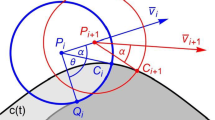Abstract
Plunge milling plays an important role in machining of components with cavity structures. As a non-continuous material removal strategy, residual material is inevitably remained between two adjacent plunge cutter locations, also named as scallop. Large scallop height causes machining error, as well as fluctuations of cutting width in the following machining operation like semi-finish milling. As such, a constant scallop from plunge milling is essential to improve machining stability and tool life in following operation. In this paper, a new plunge milling toolpath generation method with adaptive interval is developed to restrict the maximum scallop height within a given value. Geometric relationship between plunge tool location and cusp of the constant scallop is firstly analyzed to determine the curves that the cusp of the constant scallop and plunge tool location located on. Then an iterative cusp of the constant scallop calculation algorithm is constructed based on the constructed geometric relationship. The next plunge tool location is obtained through a similar algorithm. Therefore, interval between current and its previous tool location is determined. In this way, the generated plunge milling toolpath can satisfy the given machining error allowance and keep a constant scallop height. It also has minimum number of plunge cutter locations to achieve maximum machining efficiency. Advantages of the proposed method are validated through a machining experiment by comparing the machining results with conventional plunge milling toolpath with constant step interval.
Similar content being viewed by others
References
Shixiong W, Wei M, Bin L, Chengyong W (2016) Trochoidal machining for the high-speed milling of pockets. J Mater Process Technol 233:29–43
Wakaoka S, Yamane Y, Sekiya K, Narutaki N (2002) High-speed and high-accuracy plunge cutting for vertical walls. J Mater Process Technol 127(2):246–250
Huang N, Lynn R, Kurfess T (2017) Aggressive spiral toolpaths for pocket machining based on medial axis transformation. J Manuf Sci Eng 139(5):051011
Cafieri S, Monies F, Mongeau M, Bes C (2016) Plunge milling time optimization via mixed-integer nonlinear programming. Comput Ind Eng 98:434–445
Monies F, Danis I, Bes C, Cafieri S, Mongeau M (2017) A new machining strategy for roughing deep pockets of magnesium-rare earth alloys. Int J Adv Manuf Technol 92(9–12):3883–3901
Sun C, Wang YH, Huang ND (2015) A new plunge milling tool path generation method for radial depth control using medial axis transform. Int J Adv Manuf Technol 76(9–12):1575–1582
Shi Y, Zheng G (2017) The algorithm of layering calculation for corner plunge milling tool path. Int J Adv Manuf Technol 91(5–8):2059–2075
Sun C, Bi Q, Wang Y, Huang N (2015) Improving cutter life and cutting efficiency of five-axis plunge milling by simulation and tool path regeneration. Int J Adv Manuf Technol 77(5–8):965–972
El-Midany TT, Elkeran A, Tawfik H (2006) Optimal CNC plunger selection and toolpoint generation for roughing sculptured surfaces cavity. J Manuf Sci Eng 128(4):1025–1029
Chen ZC, Abdelkhalek S (2014) A new approach to planning plungers paths for efficient 2½-axis computer numerically controlled plunge milling of complex pockets with islands. J Manuf Sci Eng 136(4):041013
Han FY, Zhang DH, Luo M, Wu BH (2014) Optimal CNC plunge cutter selection and tool path generation for multi-axis roughing free-form surface impeller channel. Int J Adv Manuf Technol 71(9–12):1801–1810
Liang Y, Ren J, Zhang D, Li X, Zhou J (2015) Mechanics-based feedrate scheduling for multi-axis plunge milling. Int J Adv Manuf Technol 79(1–4):123–133
Zhuang K, Zhang X, Zhang D, Ding H (2013) On cutting parameters selection for plunge milling of heat-resistant-super-alloys based on precise cutting geometry. J Mater Process Technol 213(8):1378–1386
Lu Y, Ding Y, Peng Z, Chen ZC, Zhu L (2017) A spline-based method for stability analysis of milling processes. Int J Adv Manuf Technol 89(9–12):2571–2586
Liang Y, Zhang D, Chen ZC, Ren J, Li X (2014) Tool orientation optimization and location determination for four-axis plunge milling of open blisks. Int J Adv Manuf Technol 70(9–12):2249–2261
Wenfeng G, Jianzhong F, Zhiwei L, Yuchun L (2010) Tool-path planning based on iso-scallop for plunge milling in pocket walls manufacture[C]//Mechanic Automation and Control Engineering (MACE), 2010 International Conference on. IEEE, 3434–3437
Danis I, Monies F, Lagarrigue P, Wojtowicz N (2016) Cutting forces and their modelling in plunge milling of magnesium-rare earth alloys. Int J Adv Manuf Technol 84(9–12):1801–1820
Altintas Y, Ko JH (2006) Chatter stability of plunge milling. CIRP Ann Manuf Technol 55(1):361–364
Ko JH, Altintas Y (2007) Dynamics and stability of plunge milling operations. J Manuf Sci Eng 129(1):32–40
Ko JH (2014) Time domain prediction of side and plunge milling stability considering edge radius effect. Procedia CIRP 14:153–158
Sun T, Fu Y, He L, Chen XM, Zhang WG, Chen W, Su XB (2016) Machinability of plunge milling for damage-tolerant titanium alloy TC21. Int J Adv Manuf Technol 85(5–8):1315–1323
Witty M, Bergs T, Schäfer A, Cabral G (2012) Cutting tool geometry for plunge milling–process optimization for a stainless steel. Procedia CIRP 1:506–511
Funding
This study was financially supported by the National Natural Science Foundation of China (Nos. 51705374, 51705372), the China Postdoctoral Science Foundation (No. 2017M622509) and the Fundamental Research Funds for the Central Universities.
Author information
Authors and Affiliations
Corresponding author
Rights and permissions
About this article
Cite this article
Huang, N., Jin, Y., Lu, Y. et al. Plunge milling with constant scallop height by adaptively modifying the step interval for pocket wall. Int J Adv Manuf Technol 101, 203–208 (2019). https://doi.org/10.1007/s00170-018-2912-y
Received:
Accepted:
Published:
Issue Date:
DOI: https://doi.org/10.1007/s00170-018-2912-y



